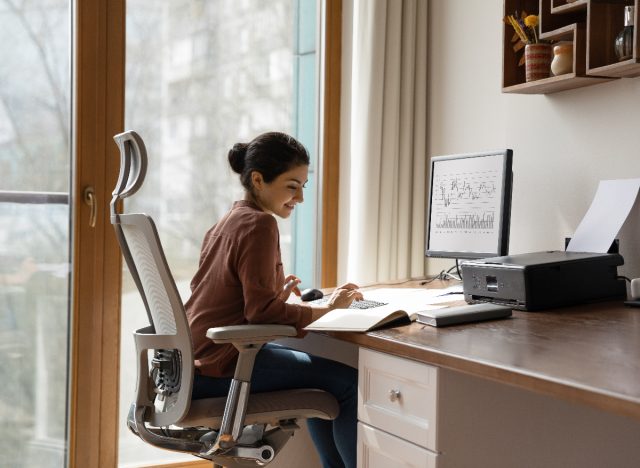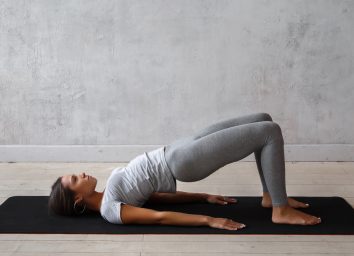3 Secret Tips To Avoid Back Pain When Sitting All Day, Expert Says

The struggle can be real when you spend a good chunk—if not all—of your workday hunched over your desk. And if you're dealing with back pain due to these countless hours of sedentary time, you're certainly not alone. With working from home being the new normal for many of us, having a comfortable desk situation is key for your mental and physical well-being. We spoke with Dr. Rahul Shah, Board Certified Orthopedic Spine & Neck Surgeon to get the details on how to avoid back pain when sitting all day.
Read on to learn more about how to avoid back pain when sitting at a desk, and next, check out The 6 Best Exercises for Strong and Toned Arms in 2022, Trainer Says.
Don't slouch!

Dr. Shah tells us, "As many new home office setups consist of sitting in bed, [on] lounge chairs, couches, or [at] kitchen tables, our home setups may not be optimized for optimal posture." To minimize any back pain when you're working at home, Dr. Shah notes it's critical to make sure you're not slouching when working at your laptop or on your phone.
Related: The Top 3 Yoga Moves For Relieving Lower Back Pain, Expert Says
Establish a work-from-home area that sets you up for good posture success

Ultimately, you want to make sure your WFH situation sets you up for success as far as your posture's concerned. Dr. Shah explains, "Ideally, try to achieve a device position that's 15-30 degrees off of the horizontal level to maintain an optimal gaze and neck posture." He adds, "With regards to the mid and low back, when setting up a home office, look for areas that allow one's pelvis to be in line with the head and avoid craning forward at the pelvis or shoulders when working."
And lastly, be sure your pelvis stays level, and keep the hips and knees bent at around 90 degrees. This can result in "optimal pelvis orientation," as Dr. Shah puts it.
Related: The Subtle Warning Signs You're Suffering From Burnout, Expert Says
Lumbar and shoulder support can help

If you're curious about support pillows, Dr. Shah reveals the importance of both lumbar support and shoulder support pillows. "Sometimes a lumbar support pillow can help to ensure that a swayback is maintained in the lower spine," he says, adding, "Using any pillows to help support one's shoulders to keep them in line with [the] pelvis can help to minimize upper neck ache and mid backache."
Sitting back in your chair is key, as it will "help restore the normal swayback the lower back typically has when standing." Ensuring the lower spine has that swayback can help you avoid feeling tired and straining your muscles.
For more…

For more Mind + Body news, check out The Best Immune-Boosting Workout For People Over 60, Trainer Says and 5 Best-Kept Secrets To Losing Weight In Your 50s, Trainer Says.








